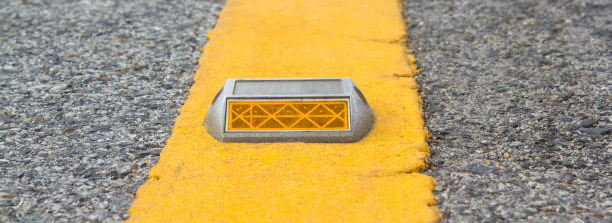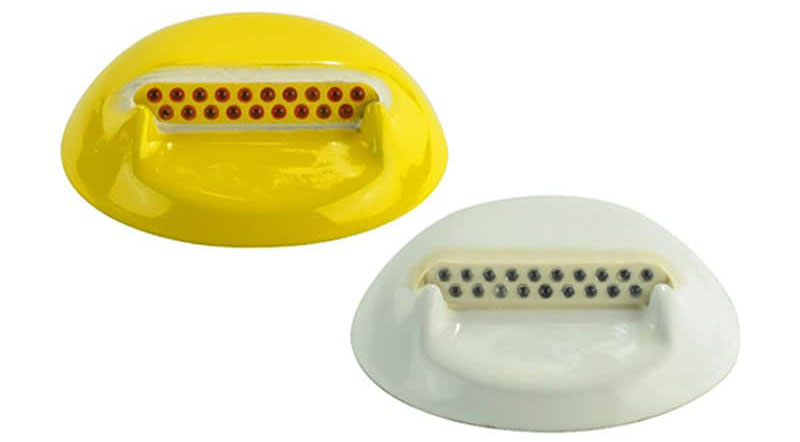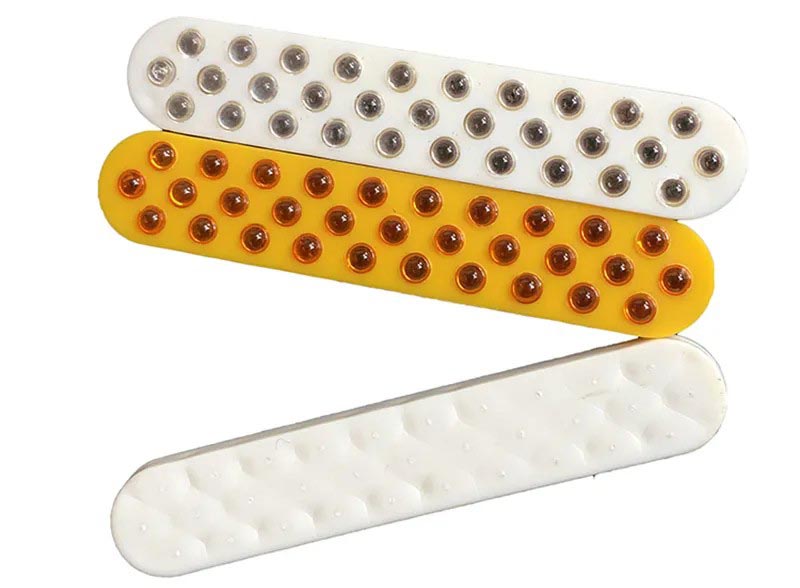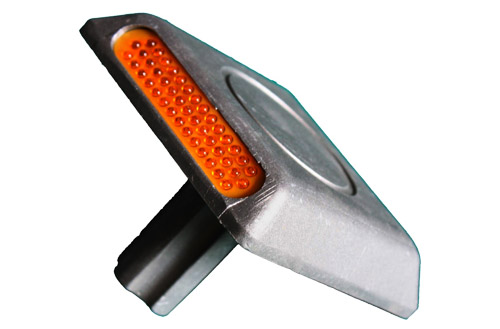When we think about road safety, we often picture signals, traffic signs, and freshly painted lanes. But another crucial element that quietly encourages safer driving is road reflectors. These little, often overlooked devices greatly improve nighttime visibility, lane guidance, and driver awareness, particularly in challenging conditions like fog, rain, or darkness. Because they are robust and extremely effective, road reflectors are an essential part of modern road infrastructure that helps prevent accidents and save lives.
What are Road Reflectors?
Road reflectors, also called raised markers (RPMs), Bott’s Dots, traffic delineators, raised pavement markers, road studs, street reflectors, or road cat’s eyes, are security instruments set on streets to assist individuals in seeing and following the path, particularly when road reflector at night or in bad weather like rain or mist. These reflectors are more often made of solid materials like plastic, ceramic, or metal. They have shrewd parts, frequently made of glass dots or crystals, that send light from car headlights back to the driver’s eyes.
Road reflectors are put along the ways, centerlines, or the edges of lanes. They offer assistance at points where individuals or vehicles go, point out bends, and warn drivers approximately changes within the street. A few signs use solar-powered control and send out lights to make them more unmistakable. They are frequently utilized as road reflectors for driveways, highways, at crosswalks, and in areas where accidents happen regularly to improve street security.

Types of Road Reflectors
Road reflectors are made of different materials.
1. Plastic Road Reflectors
Plastic reflectors are made from extremely lightweight plastic. They are easy to set up and cheap. They regularly have uncommon tape or focal points that bounce back car lights. They aren’t as solid as other sorts, but individuals regularly utilize them for temporary marks, city streets, or places with little activity. A few designs are suggested to ensure the car’s weight, particularly amid accidents.

2. Ceramic Road Reflectors
JACKWIN ceramic road reflectors are made of ceramic material fired at high temperatures and offer assistance to individuals to see way better, while keeping surfaces secure to walk on. Their white or yellow arch shape makes them simple to see during the day. They ought to sparkle well at night when it’s damp, but they are also accommodating in hot places or city boulevards where it doesn’t rain frequently. They are frequently utilized to create partitioned ways or show where the street closes, and their smooth surface makes a difference tires last longer.

3. Glass Bead Reflectors (Cat’s Eyes)
Glass bead Reflectors, also known as Cat’s Eyes, are conventional street markers with glass pieces interior a metal or adaptable cover. When car headlights hit them, they reflect the light back to the driver, so they are simple to see at night. The body more often than not keeps itself clean, and sweating makes a difference in getting rid of dirt. Cat’s eyes are more often than not found on active roads, within the center of the street, and in regions with haze. They offer great light at night and when it’s dull.

4. Metal Road Reflectors or Raised Reflective Markers
Metal road reflectors are made from extreme materials like aluminum or stainless steel. They are exceptionally solid and made to support heavy vehicles and withstand difficult thumps. They, as a rule, have shining reflectors or glass balls, which make them great for active places, interstates, convergences, and sharp turns. They are solid and can handle an awful climate, making them ideal for utilize in intense conditions for a long time.

5. LED Road Reflectors or Solar-Powered Reflective Markers
These reflectors have sun-oriented boards and lights interior them. During the day, they assemble daylight to charge up, and at night, they naturally sparkle, shining to light up road corners, center lines, or crosswalks. Their solid and unfaltering lights help them perform well in perilous places, burrows, or nation streets with weak light. They basically make things more secure, particularly in swarmed places or zones where accidents might happen.

6. Snowplowable Road Reflectors or Recessed Reflective Markers
Snowplowable Road Reflectors are made for places that get heavy snow. They are put within the road and secured with intense steel or cast iron so they can handle being hit by snowplows. The intelligent portion is tucked absent so it doesn’t get scratched. These are utilized on thruways, mountain roads, and bridges to assist people see well when snow is cleared absent.
How Do Road Reflectors Work?
Street reflectors work by reflecting light from vehicle headlights back toward the driver, improving perceivability and directing traffic, especially in low-light or destitute climate conditions. Most street reflectors contain retroreflective materials such as glass dots, kaleidoscopic focal points, or microprisms. These materials are planned to twist and bounce light back within the heading it came from, making the reflector show up to glow when headlights hit it. This retroreflection makes a difference; drivers see path markings, bends, street edges, and risks at night or during mist, rain, or snow.
A few street reflectors, especially solar-powered driven reflectors, go a step encourage by utilizing built-in solar cells to store energy during the day and emit light at night. These dynamic reflectors flash or sparkle relentlessly to supply indeed more noteworthy perceivability in basic zones like sharp turns, person on foot intersections, and accident-prone zones. The arrangement of street reflectors on path lines, centerlines, and shoulders is moreover carefully arranged so drivers can translate the street format indeed in total obscurity. This makes road reflectors a crucial instrument for progressing nighttime security, lessening accidents, and helping in path teaching.
What Is Road Reflector Color Meaning (Cat’s Eyes) ?
Whereas the colors and implications of road reflectors can be diverse in different parts of the world, keep in mind that there are a few likenesses during your street trip, as well.
White Road Reflectors
Within the U.S, white reflectors are utilized to check paths or set on the correct side of the street. In Europe and the U.K., white cats’ eyes check streets and ways, making a difference drivers remain on track and appearing where to walk securely.
Yellow Road Reflectors
In the event that you see a yellow reflector within the U.S, it appears where activity is going in inverse headings or marks the cleared edge of one-way boulevards. In Europe and the U.K., yellow also marks the side of the central divider. But a shining reflector within the U.S says that the road you need to utilize is closed, otherwise you are going the off-base way.
Red Road Reflectors
In Europe and the U.K., ruddy cats’ eyes are put on the road’s edges to assist stamp out the cleared side. In Europe and the U.K., the color green is utilized to stamp intersections, street intersections, and exits, but it’s not regularly utilized to mark the front of a road.
Green Road Reflectors
Green street reflectors in the U.S Some of the time is used in figuring out the best ways for emergency vehicles to enter a gated community fast, which helps emergency services find the quickest spots to get in.
The Importance of Road Reflectors
1. Enhanced Nighttime Visibility:
Road reflectors offer assistance to drivers to see better at night by bouncing car headlights back towards them. This intelligent inclusion makes a difference in making the lines on the street, like way divisions, edges, and bends, less demanding to see when road reflective paint markings might not be exceptionally clear.
2. Security in a Terrible Climate
In haze, rain, or snow, painted lines can end up difficult to see or vanish. Road reflectors give a clear visual direction that remains obvious in intense conditions, making a difference in decreasing the chance of cars going off their way or veering off the street.
3. Knowing Approximate Dangers in Unsafe Zones
Reflectors put close, sharp turns, active intersections, or soak slopes offer assistance to drivers to see potential perils early. This gives you more time to respond, moderate down, or alter your way, which makes a difference in maintaining a strategic distance from mishaps.
4. Energetic Brightening with Solar-Powered Road Reflectors
Solar-powered road reflectors light up at night in a dynamic way. These are particularly valuable in dull nation boulevards, building regions, or neighborhoods where there’s little or no road lighting. They can streak or shine continually to induce drivers to pay attention.
5. All-Weather Convenience:
Snowplowable road reflectors are planned to resist snow expulsion hardware and extreme winter weather. Their solid arrangement makes it beyond doubt that individuals can still see the ways indeed after the snow is cleared, keeping the ways secure in frigid zones.
6. Solid and Easy-to-Manage Security Instrument
Street reflectors are made from intense materials like plastic, ceramic, or metal, which implies they can final a long time with exceptionally small upkeep. Once they are put in place, they give solid and reasonable security in numerous circumstances.
Uses of Road Reflectors on Roads
1. Lane Separation and Guidance
Road reflectors are commonly utilized to stamp the edges of streets, particularly on highways, curved boulevards, and at night. They offer assistance to drivers to remain in their lanes and avoid inadvertently drifting, particularly when the lines are difficult to see.
2. Edge Line and Shoulder Marking:
Reflectors are put along the sides of boulevards to check the line between the pathway and the roadside. This can be particularly supportive in country regions or on high streets where going off the street can result in unsafe drops.
3. Highlighting Intersections and Pedestrian Crossings
Reflectors are utilized at crosswalks and roundabouts to alert drivers to slow down and observe for pedestrians. Solar-powered or battery-operated reflectors are regularly put in these ranges to make them easier to see.
4. Action Stream Course and Way Control
Diverse colors of reflectors (like white, yellow, and red) offer assistance in appearing action stream signs or edges:
- White: lane markers
- Yellow: centerline or opposing traffic
- Red: wrong-way or do-not-enter zones
Road Reflectors Installation and Maintenance
1. Installation Methods
Road reflectors can be:
- Put on the surface utilizing a solid stick or epoxy, then the road reflector adhesive is strictly stuck on the ground.
- Put within the black-top utilizing grooves and held in place with epoxy.
- Shot or attached (mostly for heavy-duty or metal reflectors).
Some time recently, when putting them within, the street surface was cleaned and dried to ensure they adhered well. The circumstances are carefully surveyed based on the sort of road, what individuals are doing, and how unmistakable things ought to be.
2. Types of Roads for Installation
Reflectors are installed on:
- Highways and expressways
- City and rural roads
- Airport runways and taxiways
- Tunnels and bridges
- Pedestrian crossings and parking areas
3. Maintenance Practices
Regular maintenance incorporates:
- Cleaning: Reflectors can get grimy from mud, oil, or snow, which makes them less effective.
- Substitution: Harmed or worn-out reflectors ought to be evacuated and replaced immediately.
- Snowplow-friendly reflectors might need to be checked frequently to ensure beyond any doubt they are still solid after heavy snow evacuation.
4. Quality and Climate Resistance
Most cutting-edge road reflectors are designed to resist overwhelming utilization, daylight, water, and changes in temperature. Sun-powered and battery-powered models require normal checks of the battery or boards to form beyond any doubt they work properly.
Temporary vs Permanent Reflective Pavement Markers
When we look at how long they last, savvy road reflector markings can be separated into two sorts: temporary reflective markers and permanent street markers. Temporary RPMs are, as a rule, made of plastic or elastic, and they are connected to the street with a stick. They are simple to put in and take out, but not as solid as permanent RPMs. When exposed to an awful climate or overwhelming utilize, these road marking reflectors will wear absent rapidly.
So, you’ll count on them for short-term ventures like road building, support, and repairs. Permanent reflective markings are made from materials like ceramic, glass, or metal. They are joined utilizing cement or epoxy, which holds them to the street. This solid association makes a difference them handling intense exercises and cruel climate, much superior to their competitors’ temporary road reflectors.
In any case, permanent markings are more grounded than temporary ones, but they are more costly and harder to customize. A gifted installer with the proper apparatuses can work with them. Both sorts of RPMs make strides in street security and route. The choice between the two depends on what the venture or circumstance particularly needs. Temporary RPMs are utilized for fast roadwork ventures, whereas permanent RPMs are superior for active streets and longer ventures.
Jackwin & Road Reflectors for Sale
Searching for a reliable partner for road security equipments? Jackwin can be your road reflectors supplier and a reliable manufacturer of road safety equipments partner. They center on making high-quality raised markers, solar-powered LED road studs, and cat’s eyes for thruways, city streets, burrows, and stopping areas.
They provide items to wholesalers, government temporary workers, framework builders, and bulk buyers around the world. Whether you would like bulk orders, custom requirements, or extraordinary arrangements, we offer security with care that meet internal safety regulations and polished skill. Approach Jackwin today as your trusted b2b supplier of road reflectors for businesses, advertising shrewd, and wholesalers. Time to contact us now for quotes, catalogs, or free samples!
Conclusion
In conclusion, by reflecting light from vehicle headlights, road reflectors are essential traffic safety devices that improve driving at night and in low visibility. Whether they are embedded or surface-mounted, these markings provide clear lane direction, enhance general road awareness, and highlight hazards. Due of their lifespan, visibility, and strategic placement, they are a simple yet efficient way to reduce accidents and promote safer road infrastructure.
FAQs Section
What do the blue reflectors on the road mean?
Blue reflectors indicate where fire hydrants are located. They help emergency responders quickly find fire hydrants at night or when it’s hard to see.
What are the reflectors on the road called?
They are usually called street reflectors, raised markers, or cat’s eyes.
Where Are Road Reflectors Typically Used?
Street reflectors are used on highways, city and country roads, intersections, crosswalks, tunnels, bridges, and sharp turns to improve visibility and safety for drivers.
What Are Snowplowable Road Reflectors?
They are special reflectors made from metal or set into the ground, designed to withstand snowplow blades and tough winter weather without getting broken or coming loose.
How Long Do Reflectors Last?
Street reflectors can last 3 to 10 years, depending on how much they are used, the material they are made from, and the environment. Ceramic and metal reflectors tend to last longer than plastic ones.
What Kind of Stress Testing Is Done on Road Reflectors?
The following tests include:
- Compression and impact resistance
- Weathering and UV exposure
- Adhesion strength
- Snowplow abrasion testing for snowplowable models
What are Special Colors For Emergency And Utility Markings
These are special road reflector colors used for emergency situations.
- Blue: Fire hydrant locations
- Green: Emergency vehicle access or private roads
- Purple: Reclaimed or non-potable water lines
- Orange: Temporary construction zones


-80x69.png)

